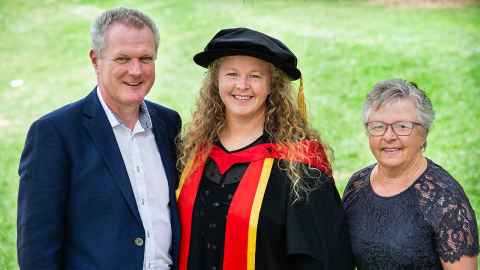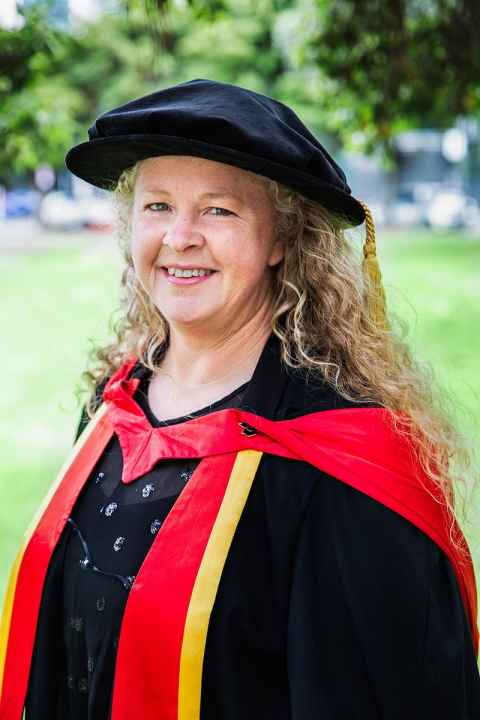A bioengineering approach to physiotherapy
9 November 2020
Physiotherapists use their hands to assess the muscle stiffness of different muscle groups, commonly described as ‘muscle tone’ or ‘tightness’, but can a physiotherapist really trust what their hands tell them?

Perhaps not as much as we might think, according to the research of Melissa Davidson, who completed her PhD with the Auckland Bioengineering Institute (ABI), graduating this month.
Melissa is one of ten registered specialist physiotherapists in the country and the only registered specialist physiotherapist in pelvic health.
She continues to work in clinical practice as a physiotherapist, as she did while studying for her PhD. Melissa was keen to advance our understanding of pelvic floor health, but also aware that approaching clinical problems from a different perspective can create new insights.
She completed a Masters at the University of Melbourne and then approached the Pelvic Floor Research group at the ABI to further her research closer to home.
Hundreds of thousands of women in New Zealand are struggling with urinary incontinence. It affects an estimated 80 percent of pregnant women and more than 30 percent of women post-partum.
Contrary to popular perception, urinary incontinence is not the result of a weak bladder. “It is pelvic floor dysfunction and it’s treatable,” says Melissa.
It is rarely too late for women to start doing their pelvic floor exercise. “There’s no limit on age. I’ve had 90-year-olds improving their pelvic floor muscles.”
Yet while we have got better at talking about a wider range of health issues, such as depression or excess weight, women still don’t typically turn up to their doctor and talk about urinary incontinence. If they do, they might be told “it’s what happens to women who’ve given birth, just wear a pad and put up with it,” says Melissa.
Our pelvic floor muscles are not well understood, not even by clinicians, she says. Physiotherapists (and gynaecologists, doctors, surgeons and other medical experts) assess the muscle stiffness of a patient’s pelvic floor muscles - how well a muscle resists deformation in response to an applied pressure - as part of an internal vaginal examination.
One of the primary aims of Melissa’s research was to assess how reliable this method of assessment, called palpation, really was.
Taking advantage of the skills at the ABI, and to further her own understanding of instrumentation design and development, she worked closely with bioengineers to develop a novel device, a ‘Palpation Device’.
Over 130 physiotherapists were asked to rate muscle stiffness by palpating the device that was able to mimic the feedback that physiotherapists typically experience when examining the pelvic floor muscles. The ‘stiffness’ could be set at various levels. Participants were then asked to rate the stiffness of the muscle, using a seven-point muscle stiffness palpation scale.
As Melissa’s research found, palpation is an extremely subjective assessment tool – what one clinician might consider +3 on the scale might be rated -2 on the scale by another.
“There is no standardised training in the use of palpation, and yet we are using it to assess patients and recommend treatment globally,” says Melissa.
She points out that this is not the only method of assessment used by physiotherapists and other clinicians, but one that she would recommend they use with caution. “If palpation is going to be used as a method of assessment, we need a validated and reliable scale to be developed, and training given using an objective measuring device – like the Palpation Device.”
She would still recommend that women who are suffering urinary incontinence see a pelvic health physiotherapist to get expert professional advice on how to do correct pelvic floor exercises.
Performing pelvic floor exercises regularly and correctly is likely to improve and alleviate the condition. Research at the ABI led by Melissa’s supervisor, Dr Jenny Kruger has shown that 30 percent of women will suffer from urinary incontinence at some stage of their lives but the issue can, in the majority of cases, be resolved with correct and regular pelvic floor muscle exercises.
Melissa also notes that it is rarely too late for women to start doing their pelvic floor exercise. “There’s no limit on age. I’ve had 90-year-olds improving their pelvic floor muscles.”
Melissa has come from a completely different clinical background, but doing her PhD has enable her to get absorbed and involved in a different discipline, says Dr Kruger. “She’s now in a great position to communicate to her peers how bioengineering allows us to look at clinical issues in a different light.”

Media contact
Margo White I Media adviser
DDI 09 923 5504
Mob 021 926 408
Email margo.white@auckland.ac.nz